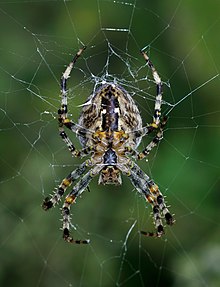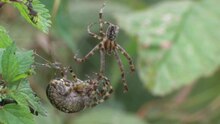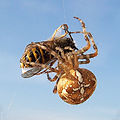Garden spider
| Garden spider | ||||||||||||
|---|---|---|---|---|---|---|---|---|---|---|---|---|

Garden spider ( Araneus diadematus ), female |
||||||||||||
| Systematics | ||||||||||||
|
||||||||||||
| Scientific name | ||||||||||||
| Araneus diadematus | ||||||||||||
| Clerck , 1757 | ||||||||||||
| Subspecies | ||||||||||||
|
The garden spider ( Araneus diadematus ) is in Central Europe most common representative of the genus of spiders . The garden spider was Spider of the Year 2010.
features
The garden spider can easily be recognized by the bright spots that are combined to form a cross. The spots are on the upper side of the abdomen and are made up of four elongated spots and a small, circular spot in the middle. The basic color of the spider is very variable. It can adapt its color to the brightness of its surroundings.
It is one of the largest native spiders. The body length of the females can be up to 18 mm, that of the males about 10 mm.
distribution and habitat
The garden spider occurs in all of Central Europe. In the open countryside, it can be found frequently and steadily in orchards ; in pine forests , raised bogs and beech-fir forests , forest edges and hedges , it is somewhat rarer, otherwise steady, but rarely in meadows, fields and gardens. In the lowlands it can be found in these biotopes in the Straten shrub and crown layers. Their distribution in the Holarctic decreases rapidly with increasing altitude.
Catching prey and feeding
Garden spiders feed on whatever insects they can catch in their webs. Larger insects such as wasps, bumblebees, bees, flies, butterflies and hornets are also potential prey animals. The prey caught in the web is bitten by the spider and wrapped in a secretion tape of varying width from the spinneret. She turns the prey quickly with her legs. Digestive enzymes released upon bite decompose the inside of the prey. When the spider is full, it first spins its prey and hangs it in its web as a supply.
Reproduction
The mating season begins in August; the males are often eaten by the larger females. The males spin an application thread on the female's web and pluck it. The female recognizes the male by plucking. If the female is willing to mate, she leaves the middle of the net and goes to the male. The pairing only takes a few seconds and is usually repeated several times. In autumn, the female then lays the eggs in yellowish cocoons made of particularly finely spun threads and dies. The eggs overwinter in the cocoon, the young hatch in April / May, the hatched animals overwinter again and do not become sexually mature until the following year.
Danger
The species is one of the most common orb-web spiders and is not endangered in Europe.
toxicity
With their bite, cross spiders can only penetrate human skin at its thinnest points. The bite is just uncomfortable and medically without long-term consequences, but it can cause clearly noticeable symptoms.
use
In homeopathy known as Aranea diadema , finds the garden spider in the whole processes used in homeopathic remedies. There is no evidence of a medical effect.
gallery
A garden spider liquefies its prey.
literature
- Ambros Hännggi, Edi Stöckli, Wolfgang Nentwig: Habitats of Central European Spiders , Miscallanea faunistica Helvetiae, Center suisse de cartographie de la faune, CH-2000 Neuchâtel 1995. ISBN 2-88414-008-5
- Heiko Bellmann: Cosmos Atlas of the Arachnids , Franckh-Kosmos Verlag, 3rd edition 2006, Stuttgart, ISBN 978-3-440-10746-1
Web links
Araneus diadematus in the World Spider Catalog
Individual evidence
- ↑ R. Blanke and F. Merklinger: The variability of drawing pattern and brightness of the abdomen in Araneus diadematus Clerck and Araneus marmoreus Clerck (Arachnida: Araneae). Journal of Zoological Systematics and Evolutionary Research 20, 1983: 63-75.
- ↑ (see Hencke, AHZ 55 (1858) 166).











